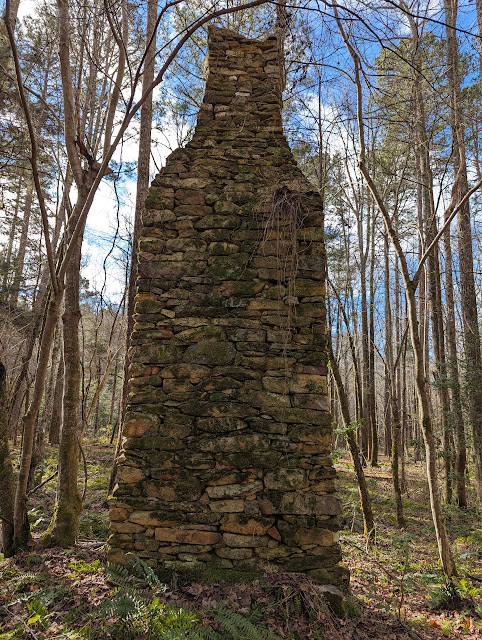It started out as just a hike to check out some trees reported across the trail. All four blowdowns were on the Birkhead Mountain Trail near the Hannah Creek crossing. After looking at the blowdowns, I proceeded to the creek to see how the trail looked south of there.
Here is the creek crossing. Too much water to make a crossing on a cold day. Opting to see how the ford at Plantation Road looked, I hiked through the thicket in the floodplain.
Here is the sign where the Uwharrie Trail used to cross the creek. The bridge is long gone and building a bridge so deep in the wilderness would be a monumental effort. Wilderness rules prohibit motor vehicles, battery tools, wheeled vehicles, chain saws, helicopter drops and so on.
Channel cut alongside the creek
Now, it became a challenge to cross the creek safely. The ford was too deep and the usually good spot to rock hop across next to the ford looked iffy. I continued to a bend in the creek. This spot pictured above, is a 600 foot long channel dug beside the creek. It is filled with standing water today.
Large pile of rocks
There is a large pile of rocks upcreek where the channel begins. It does not look a dam, just a huge pile of rocks. It looks like there must have been a purpose for all this but it was not apparent to me. This area can be accessed off the trail to camp 6. Beyond Camp 6 is a manway that follows the creek for a quarter mile of so before petering out.
Further upcreek where Plantation Road crosses the creek a second time, there is a dam. Joe Moffitt wrote that Kit Bingham had a gristmill here but this looks more like a detention dam than a grist mill dam.
Breeched dam on a tributary
Near the dam is another small dam on a tributary. This one looks to have impounded a large area.
Joe Moffitt wrote that Christopher "Kit" Bingham established a plantation near here about 1780. Remnants of a home at the junction of Plantation Road and the Uwharrie Trail could be his place. Plantation Road heads downhill there for 1/2 mile to the creek and dam.
Finally, I rock hopped across the creek to check out the dam on the other side, then headed upcreek. A sizeable tributary enters and the creek narrows and begins to have more declivity creating small drops and cascades.
After leaving the creek and hiking offtrail in the expanse bordered by the creek, Camp 3 and Birkhead Mountain trails, I came upon a chimney fall with a large rusting pipe like a large chimney pipe. No other signs of a home here, so perhaps it was a small cabin. Once I crossed the Birkhead Mountain trail between "Old Road" trail (as Don Childrey labels it) and Camp 5, I entered a wonderful weep of Christmas ferns and Running Cedar. I followed this weep until it ended near a tributary of Robbins Branch. It was a nice 8 mile circuit once I reached the Robbins Branch Trailhead.
























































